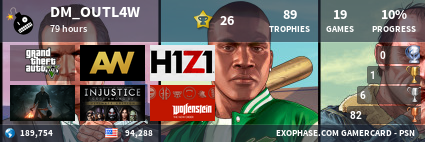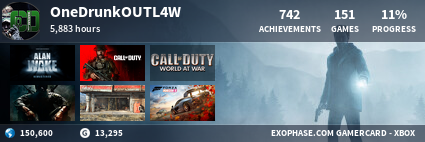Saw it on reddit and thought it was very intersting because alot of people care about the software that is playable on the consoles but the actual hardware and its capabilities are astonishing.
A basic summary for those unable to watch the video (or who were turned off by the fact that the guy in the video kept referring to DDR5...)
PS4
Memory demands from the OS
Reportedly, the PS4 OS requires about 1 GB of memory, leaving 7 GB for developers. The Xbox One employs 3 different software elements - the Xbox OS, the Windows 8 kernel (thanks amxn), with both being tied together and managed by a hypervisor. The Windows 8 partition reportedly boots when the system is powered on and runs indefinitely until the system powers down. The Xbox OS partition, on the other hand, is booted only when you're playing a game. The hypervisor manages both of these seamlessly, allowing you to multitask between gaming and other entertainment features. It's being speculated that all three software elements consume 3 GB of memory, leaving 5 GB available for developers.
Differences in the types of memory
GDDR5 and DDR3 transmit data in different ways. GDDR5 has a relatively higher latency, but delivers data in larger chunks - exactly what you would want for a GPU, but not necessarily ideal for a CPU. On the other hand, DDR3, the memory type employed by the Xbox One, transmits smaller amounts of data more quickly - this is ideal for a CPU, but not exactly the best option for a GPU.
Here's a thread from r/buildapc from about 4 months ago that goes into a bit more detail regarding the differences.
The architectures of these systems are quite profound, as they reveal the overarching philosophies of both companies. Sony's approach with the GDDR5 is ideal for gaming, as it augments the GPU and is great for developers. Microsoft's choice for DDR3 (and the eSRAM) favors the CPU a bit more and, as a result, is better for activities like multitasking.
[HR][/HR]Aside from the memory subsystems, it should be noted that the PS4 simply does have more power under the hood, with 50% more raw shader power - 768 SPs at 800mhz for the Xbox One, versus 1152 SPs at 800 mhz for the PS4. Unlike the Playstation 3, this isn't a complicated architecture to understand, and it may not take anywhere near 3+ years for developers to harness this power.
Both systems, however, are exponentially significantly more powerful than the 360/PS3. One of the key features of both next gen systems is that they have unified memory pools. In your current computer, you have system memory, but your graphics card (if it's dedicated) has its own pool of memory as well. As a result, your system has to copy data from one pool of memory to the other, which takes time and can hinder peformance.
The 8 GB memory pools in the PS4/One are unified - meaning, quite simply, that both the CPU and GPU inside the PS4/One access the same pool of memory. This can provide significant performance increases (ie, the CPU can load textures into the memory, while the GPU is rendering). If you're interested in learning more about this, simply perform a search for "hUMA" (heterogeneous unified memory access).
And, even if you only game on a PC, and not a console, you should still be pretty excited, as the new consoles will only raise the bar for PC games. Porting games among the PC, PS4, and Xbox One is going to be far easier. In fact, the developer of Warframe recently said in an interview that Sony asked only 3 months ago if they wanted to bring the game to the PS4. They agreed, Sony sent devkits, and 3 months later, they showed off Warframe footage running on PS4 devkits at E3. Edit - Here's a link to the interview
This is definitely an exciting time to be a gamer.
http://www.reddit.com/r/Games/comments/1h2qxn/xbox_one_vs_ps4_memory_subsystems_compared/caqdheg
A basic summary for those unable to watch the video (or who were turned off by the fact that the guy in the video kept referring to DDR5...)
PS4
- 8 GB of GDDR5 memory
- 256 bit bus
- ~5.5 Ghz data rate
- Peak bandwidth - ~176 GB/s.
- 8 GB of DDR3 memory
- 256 bit bus
- ~2.1 Ghz data rate
- Peak bandwidth - ~68.3 GB/s
Memory demands from the OS
Reportedly, the PS4 OS requires about 1 GB of memory, leaving 7 GB for developers. The Xbox One employs 3 different software elements - the Xbox OS, the Windows 8 kernel (thanks amxn), with both being tied together and managed by a hypervisor. The Windows 8 partition reportedly boots when the system is powered on and runs indefinitely until the system powers down. The Xbox OS partition, on the other hand, is booted only when you're playing a game. The hypervisor manages both of these seamlessly, allowing you to multitask between gaming and other entertainment features. It's being speculated that all three software elements consume 3 GB of memory, leaving 5 GB available for developers.
Differences in the types of memory
GDDR5 and DDR3 transmit data in different ways. GDDR5 has a relatively higher latency, but delivers data in larger chunks - exactly what you would want for a GPU, but not necessarily ideal for a CPU. On the other hand, DDR3, the memory type employed by the Xbox One, transmits smaller amounts of data more quickly - this is ideal for a CPU, but not exactly the best option for a GPU.
Here's a thread from r/buildapc from about 4 months ago that goes into a bit more detail regarding the differences.
The architectures of these systems are quite profound, as they reveal the overarching philosophies of both companies. Sony's approach with the GDDR5 is ideal for gaming, as it augments the GPU and is great for developers. Microsoft's choice for DDR3 (and the eSRAM) favors the CPU a bit more and, as a result, is better for activities like multitasking.
[HR][/HR]Aside from the memory subsystems, it should be noted that the PS4 simply does have more power under the hood, with 50% more raw shader power - 768 SPs at 800mhz for the Xbox One, versus 1152 SPs at 800 mhz for the PS4. Unlike the Playstation 3, this isn't a complicated architecture to understand, and it may not take anywhere near 3+ years for developers to harness this power.
Both systems, however, are exponentially significantly more powerful than the 360/PS3. One of the key features of both next gen systems is that they have unified memory pools. In your current computer, you have system memory, but your graphics card (if it's dedicated) has its own pool of memory as well. As a result, your system has to copy data from one pool of memory to the other, which takes time and can hinder peformance.
The 8 GB memory pools in the PS4/One are unified - meaning, quite simply, that both the CPU and GPU inside the PS4/One access the same pool of memory. This can provide significant performance increases (ie, the CPU can load textures into the memory, while the GPU is rendering). If you're interested in learning more about this, simply perform a search for "hUMA" (heterogeneous unified memory access).
And, even if you only game on a PC, and not a console, you should still be pretty excited, as the new consoles will only raise the bar for PC games. Porting games among the PC, PS4, and Xbox One is going to be far easier. In fact, the developer of Warframe recently said in an interview that Sony asked only 3 months ago if they wanted to bring the game to the PS4. They agreed, Sony sent devkits, and 3 months later, they showed off Warframe footage running on PS4 devkits at E3. Edit - Here's a link to the interview
This is definitely an exciting time to be a gamer.
http://www.reddit.com/r/Games/comments/1h2qxn/xbox_one_vs_ps4_memory_subsystems_compared/caqdheg



















